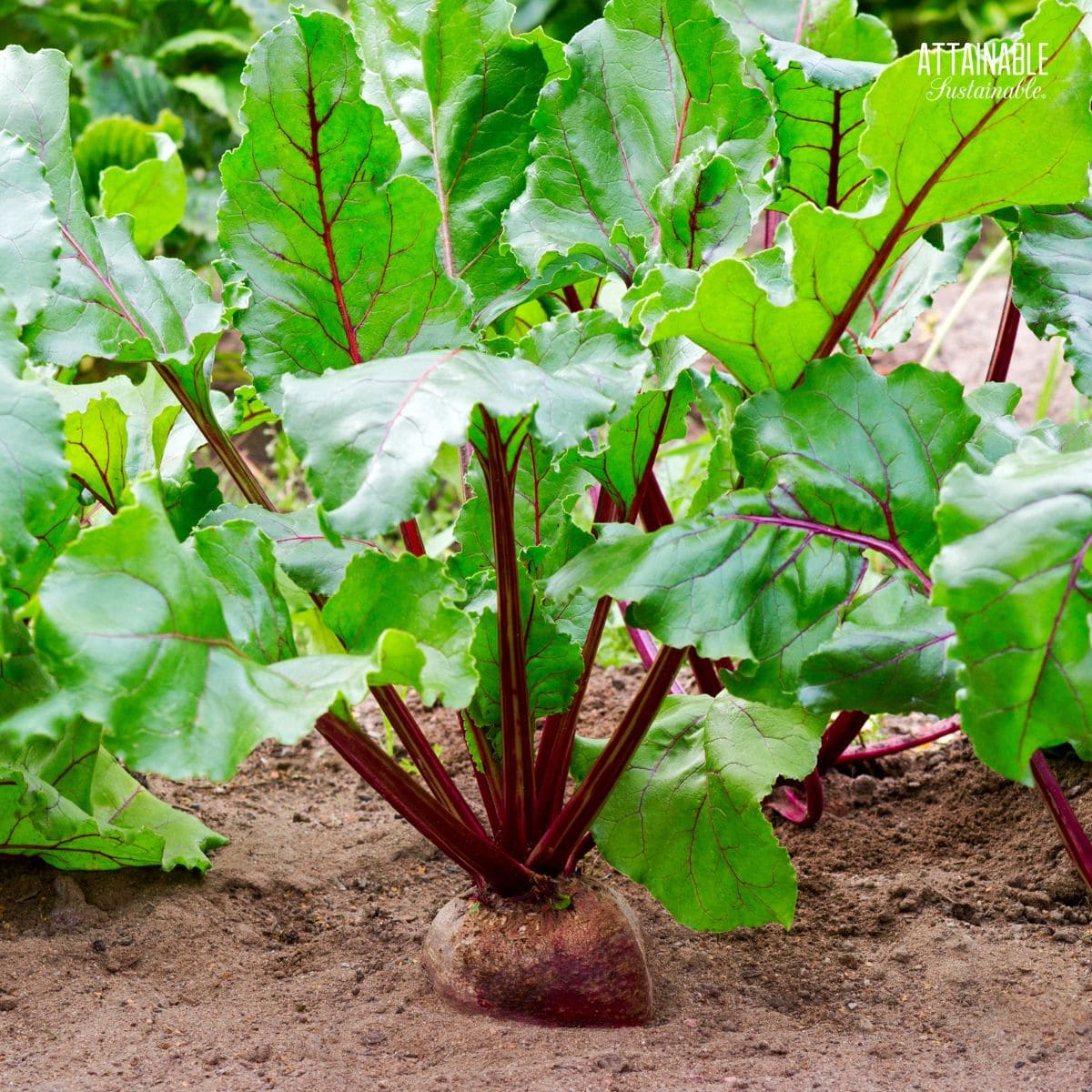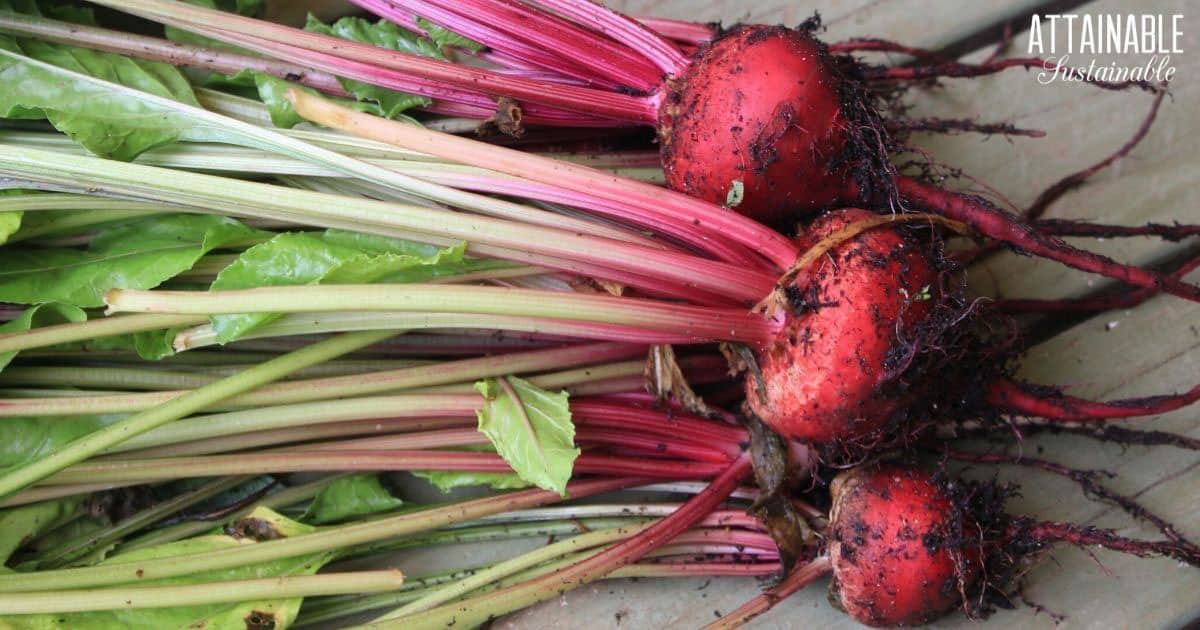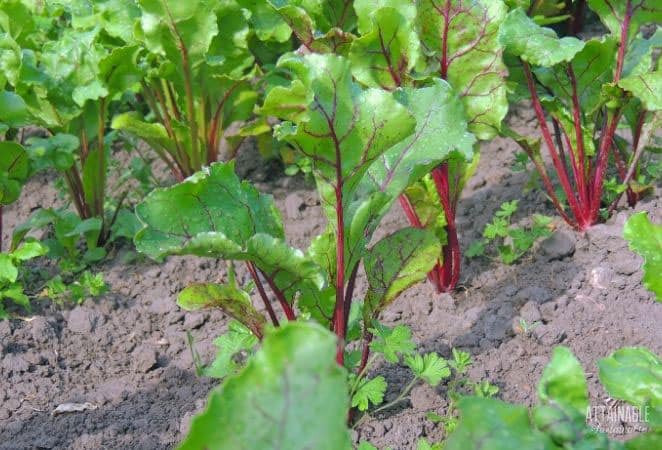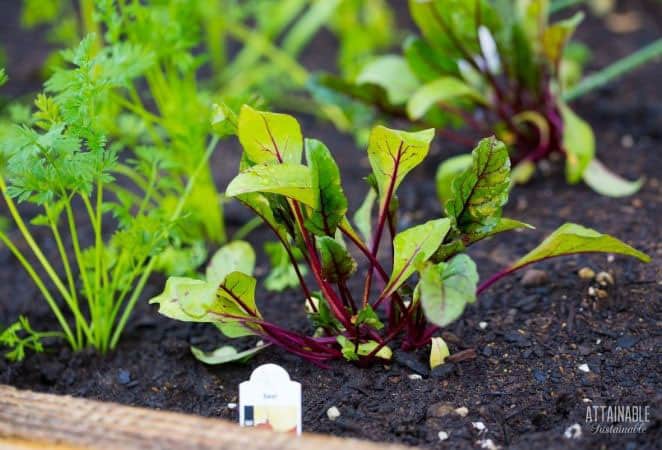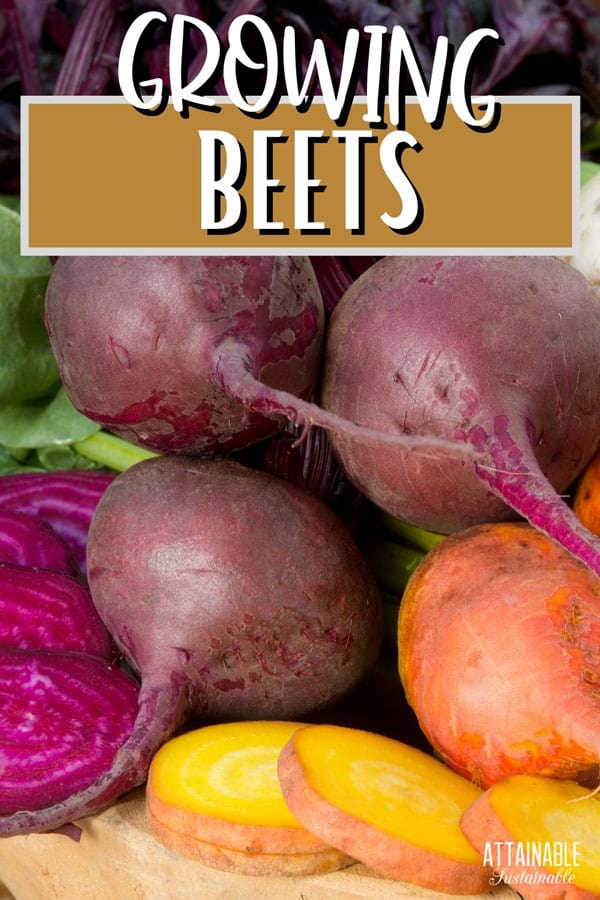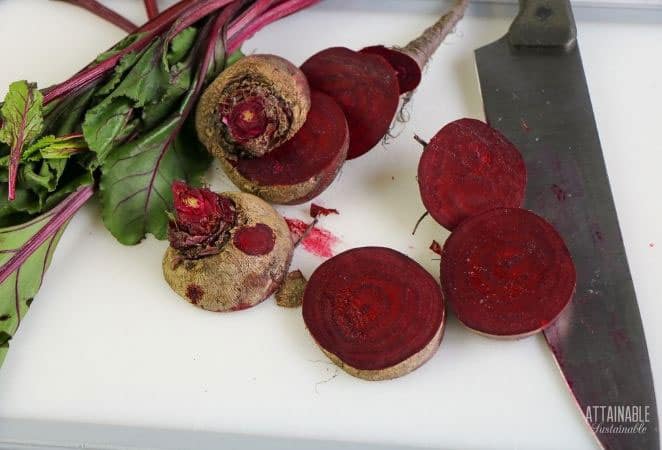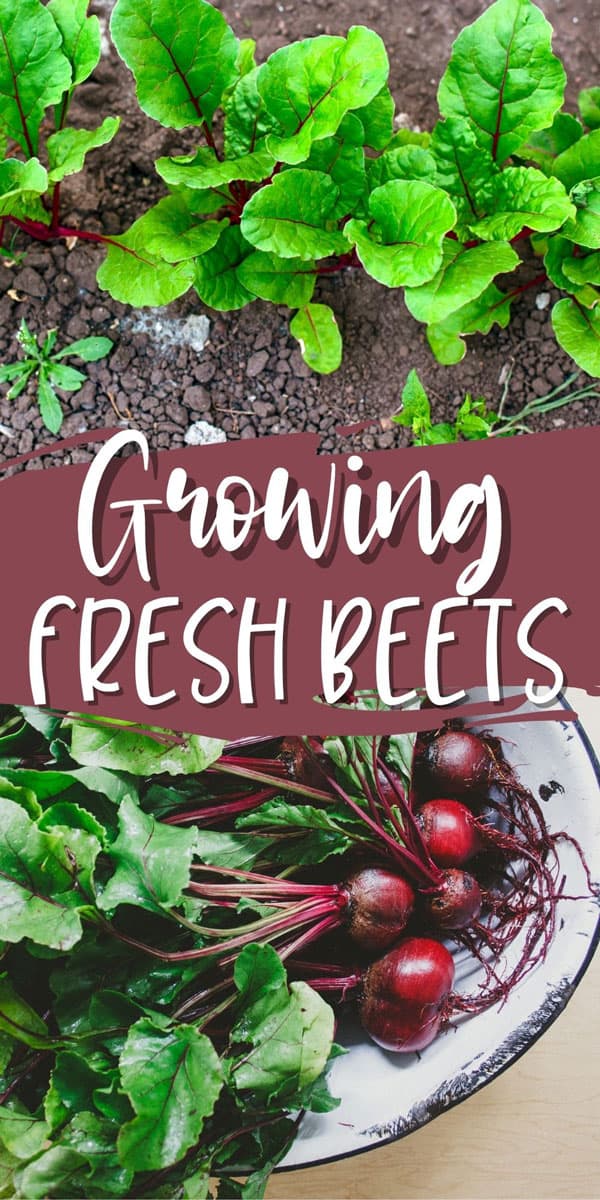Growing beets in your garden will net a delicious harvest; the flavor of fresh beets outranks the canned version by leaps and bounds.
Carrots are another great root crop for your veggie patch – be sure to read about Grandpa’s secret for germinating carrots!
Contributed by Jodi Torpey, author and Master Gardener.
Nothing Beats Homegrown Beets
Round and ruby-red is what most people think of when they hear the word beets, but there are many more options to plant and grow.
Beet colors include gold, white, and some with red and white concentric interior rings. Root shapes can vary from perfectly round and globe-shaped to long and cylindrical. There are carrot-shaped beets and beets with flat roots.
Grow Some Greens!
Ready to grow fresh greens, no matter WHERE you live? Sign up for my
FREE quick-start guide and start growing some of your own food!
What’s so Great About Beets?
Beets are one of those exceptional double-duty vegetables because both the plant’s roots and leaves are edible. The beets we eat today likely evolved from the wild beet greens originally found growing along the Mediterranean coast.
Beets (Beta vulgaris) are a cool-season crop that can be planted early in the season and again for a fall harvest. Plants can take a light frost and they’re easy to grow from either seeds or transplants.
Beets need a fairly sunny spot, but can grow even if there’s some shade. Plant them in vegetable gardens, raised beds, tall elevated cedar beds (the kind with legs like a table) or even in large containers.
Popular Beet Varieties for Growing in Home Gardens
So many beets, so little garden space!
For the best selection of beet varieties, choose to plant seeds. Few garden centers stock the uncommon types of beets and stick with more traditional varieties instead.
When selecting beets to grow from seeds, keep in mind beet seeds are a bit different from other vegetable seeds. Each “seed” is actually made up of a cluster of several seeds that may sprout at different times. Depending on the variety, beets can take between 55 to 70 days to reach maturity from when they’re planted.
Read descriptions carefully to make sure you’re choosing a variety that grows the beets you want for eating because some beet seeds are planted for their greens instead of their roots.
Here are a few different suggestions for beets to add to your home garden:
Early Wonder is one of the earliest beets, maturing in about 50 days, and having tall tasty greens. The deep red roots are good for eating fresh or pickling at a size of 3-4 inches.
Chioggia is a 55-day Italian heirloom beet known for its bright pink and white striped interior rings that are pretty when sliced. Small 2-inch roots are perfect for small space gardens and the greens are mild tasting.
Avalanche is a white beet and an All-America Selections vegetable winner from 2015. It’s a winner for a 51-day harvest, with a sweet mild taste and pure white roots, adaptable to different growing conditions with good disease resistance.
Golden Detroit is a beet of a different color with its bright golden interior. Sweet and mild with greens for cooking or eating in salads. 55 days to maturity.
Cylindra is a 60-day red beet that fits its name with long cylindrica roots that grow to 6-7 inches long. The length means more beet can grow in the same amount of space as round beets. Smooth skin and bold flavor.
How to Grow Beets
Wait for soil to become workable in early spring, when soil temperatures are between 50-75 degrees or about 4 weeks before the average last spring frost date. Then rinse or soak seeds in warm water to help speed germination.
Loosen the top 12 inches of soil and make sure to remove rocks and soil clods for a smooth seed bed. Spread a 1-inch layer of organic matter, like compost, over the planting area and work it in. A raised bed may give you more options for preparing a light, well-draining soil.
Without compacting the soil, plant beet seeds about 1/2-inch deep and about 1 inch apart in a row; space rows about 12-16 inches apart. Cover lightly with soil and give the seeds a light sprinkling of water.
To keep the top layer of soil aerated, you might want to cover the planting area with floating row cover cloth or burlap. Seal the cloth edges with a board or other method and use a hand sprinkler to water through the material. An alternative is to plant beets with another crop, like radish seeds, that will sprout faster and keep soil workable.
It’s a good idea to leave the cover cloth in place or stretch it over short hoops and seal the edges to give plants a healthy start and provide extra protection from pests.
If you keep planting beet seeds every two or three weeks, you’ll have a steady supply of tasty young beets into the early summer. You can also plan for when to plant to have a fall harvest.
Requirements for Growing Beets
Be Sure to Thin Growing Beets
An important growing step with beets is to thin the plants twice. If you neglect thinning, you may end up with no beets or woody and misshapen roots.
When plants are about 2 inches tall, use small scissors and thin to about 1 ½ inches apart. Cut all but the sturdiest seedling in each seed cluster. Don’t pull or you could disturb the roots of the other plants. (Be sure to rinse and eat the thinnings.)
Then, when beets are about 3-4 inches tall and the top of the root is about 1 to 2 inches in diameter, dig up every other one. Beets should be spaced about 4 inches apart. These small beets and greens are also good for eating.
Light Requirements
Beets need about 6 hours of sun every day and will grow if there’s light or dappled shade.
Soil Needs
Beets need a light, loamy soil that’s free of rocks, tree roots, soil clods or other debris. Prepare the garden bed by deeply digging in compost and well-aged manure. Be sure to keep soil soft and light to avoid problems with compaction and to help seeds germinate quickly and sprout through the soil.
A side dressing of a well-balanced fertilizer around 4-6 weeks after planting can give plants a boost. Sprinkle dry fertilizer on both sides of the rows and away from the root. Rake the fertilizer into the soil and then water.
As beets continue to grow, keep beet shoulders covered with soil and don’t let soil dry out.
Water Requirements
Keep soil evenly and consistently moist. Plan for drip irrigation or a soaker hose to ensure uniform soil moisture from the time of planting to when it’s time to harvest beets.
Combatting Pests and Other Problems
Leaf miners tunnel through greens ruining them for eating. Keep these pests from reaching leaves by covering young plants with row cover cloth, tightly sealed at the edges. Pick off and discard damaged leaves.
Flea beetles like to chew on the tasty beet greens leaving small round holes. The best way to prevent damage is to exclude them from the planting area with row cover cloth right after sowing the beet seeds. Be sure the edges are sealed, sprinkle through the cloth and leave it in place until plants are a good size.
Cercospora leaf spot is an airborne fungal disease that can harm the greens and the roots. Always water at soil level and keep leaves dry. Discard any leaves that are spotted with small, light-centered circles.
Downy mildew shows up on beet leaves as white or gray mold or causes yellow areas on beet greens. Pick off diseased leaves or pull plants and discard to keep downy mildew from spreading.
Growing Beets in Containers
You can plant beets in containers, if the container is large and 1 foot deep or more. Select a beet variety that grows smaller or longer beets to make the most of the available space.
Use a good quality potting soil meant for containers and make sure to remove any clumps to make it easy for seeds to germinate and sprout. Keep soil moist and use row cover cloth to help protect plants from pests. Space according to the plant’s instructions.
How to Harvest Beets
Beets are ready to harvest when they reach the right size for the variety you planted. Check beet size by brushing soil away from the roots. If they’re ready, use a garden fork to loosen the soil and ease the roots out of the ground.
Using Fresh Beets in the Kitchen
Cut the greens from the beets (leave about 1 inch of stem) before storing the beets in a plastic bag in the refrigerator. Beets can last up to 3 weeks when carefully stored. Wash them right before you’re ready to cook them. Wait to peel after they’ve been cooked.
Bake, roast, boil, grill, steam, can, pickle, and ferment fresh beets or use them raw and thinly sliced into salads. Prepare the greens like spinach by steaming with a squeeze of lemon or try one of these other ways to enjoy beet greens (including an easy method for preserving them!).
Saving Beet Seeds for Growing Next Year
While beets are grown as an annual, the plant itself is a biennial. Beets set a rosette of leaves and taproot the first year and then a flower stalk the next year. Sometimes a flower stalk will form the first season due to environmental conditions that cause the beets to bolt.
If you want to save beet seeds, plan well in advance and before planting. Make sure you have plenty of space between varieties to avoid cross-pollination—experts recommend a half-mile or more. Also avoid planting Swiss chard nearby to avoid pollination problems.
Save seeds from three or more plants. Seeds change from green to brown, to start to collect seeds when about 1/3 of green seeds remain. Cut stalk or pull plant to dry; clean seeds from stalks by hand over a sheet or tarp. Remove all the chaff and store seeds in airtight containers in a cool dry place.

